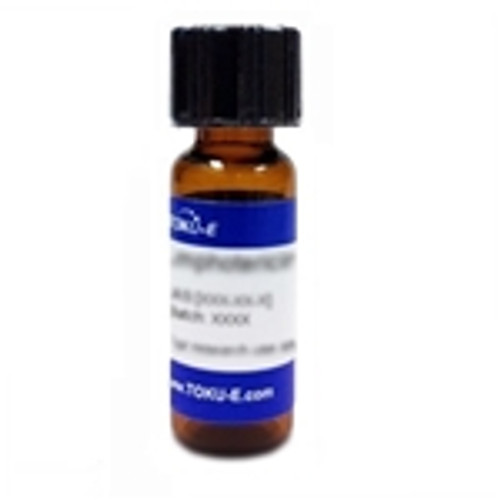Nisin (Nisin A) is a natural bacteriocin polypeptide antibiotic known as a lantibiotic. It is a 34-amino acid polycyclic antibacterial peptide. It was isolated in the late 1930s from Lactococcus lactis. Nisin A and Nisin Z are two naturally occurring variants of Nisin that differ by a single amino residue at position 27 (Nisin A=histidine; Nisin Z=asparagine).
Nisin is a proteinaceous toxin produced by Gram-positive bacteria to reduce competitive strain from other Gram-positive bacteria and it has bactericidal properties. It is used as a selective agent in microbiological media to isolate Gram-negative bacteria, yeast, and molds. It commonly used a food additive to prevent spoilage.
Nisin has been found to have anti-cancer properties in head and neck squamous cell carcinoma (HNSCC), breast cancer, and colon cancer model systems and thus is a promising agent for the development as a cancer therapeutic agent given its efficacy in vitro and in vivo, and non-toxic properties. Nisin is water-soluble.
We also offer:
| Mechanism of Action | Nisin disrupts the cytoplasmic membrane via binding to the Lipid-II wall precursor to influence cell wall synthesis and us it as a docking molecule to form short-lived pores (2-2-5 nm) that are only stable for seconds, but can change the membrane potential, allowing an influx of ions, leading to cell death. In studies with HNSCC cells, researchers found Nisin acts through the cation transport regulator homolog 1 (CHAC1) and through a CHAC1-independent influx of extracellular calcium. |
| Spectrum | Nisin is effective against a broad range of Gram-positive bacteria, but lower activity against certain intact Gram-negative bacteria since the outer lipopolysaccharide membrane shields the cytoplasmic membrane. However, pre-treatments to disrupt the cytoplastmic membrane such as heat shock, osmotic shock, or chelators (EDTA, citrates, lactoferrin) can render Gram-negative bacteria susceptible. Nano-engineering can be used to extend the spectrum for Gram-negative bacteria. |
| Microbiology Applications | Nisin is derived from culture on natural substrates such as milk or dextrose, since the chemical synthesis of this peptide is not cost-effective for industrial and large-scale applications. It can be used for food safety, as a food additive to prevent spoilage. Nisin is used as a selective agent in microbiological media to isolate Gram-negative bacteria, yeast, and mold. |
| Eukaryotic Cell Culture Applications |
In vitro studies have shown that Nisin can modulate the innate immune system by causing the secretion of chemokines and suppressing LPS stimulated cytokines. The influence of Nisin was evaluated on the proliferation and apoptosis of an astrocytoma cell line (SW1088). Cell death and apoptosis were significantly increased following Nisin treatment. This is a promising feature of Nisin for anti-cancer therapy. Diabetic foot ulcers (DFUs) are major complications of Diabetes mellitus. They are often recalcitrant to conventional antibiotics and alternatives are needed. The 3D collagen model used Nisin in combination with Pexiganan to control co-cultures of S. aureus and P. aeruginosa using a guar-gum delivery sysem (dual-AMP biogel) to eradicate S. aureus from the model (Gomes et al, 2020). |
| Cancer Applications | Nisin was found to have anti-cancer properties in studies with human head and neck squamous cell carcinoma (HNSCC), inducing preferential apoptosis and cell cycle arrest, and reducing cell proliferation. It can also reduce tumorigenesis in vivo. It exerts these effects through activation of CHAC1, a cation transport regulator, increased calcium influx, and induction of cell cycle arrest (Joo et al, 2012)
Nisin ZP, a naturally occurring variant, was found to have anti-cancer properties in studies with four human head and neck squamous cell carcinoma (HNSCC) cell lines: UM-SCC-17B (supraglottis/soft tissue-neck), UM-SCC-14A (floor of mouth), oral SCC cell lines from tongue (HSC-3 and OSCC-3). Nisin ZP induced apoptosis via a calpain-dependent pathway (Kamarajan et al, 2015). The effect of Nisin on breast cancer cells was evaluated in vitro to study its cytotoxicity/proliferation using the MTT assay with the cell line MCF-7. It had a high and selective cytotoxicity with an IC50 value of 5 µM suggesting its potential use in breast cancer (Avand et al, 2018). The effect of Nisin on colon cancer was evaluated with colon cancer cells (SW480) using MTT assay and real-time PCR and found it provokes the intrinsic pathway of apoptosis and increases bax/bcl-2 ratio in cancer cells (Ahmadi et al, 2017). |
| Molecular Formula | C143H230N42O37S7 |
| References |
Ahmadi S, Ghollasi M and Hosseini HM (2017) The apoptotic impact of Nisin as a potent bacteriocin on the colon cancer cells. Microb. Pathog. 111:193-197 PMID 28867631 Avand A, Akbari V and Shafizadegan S (2018) In vitro cytototoxic activity of a Lactococcus lactis antimicrobial peptide against breast cancer cells. Iran J. Biotechnol. 16(3):e1867 PMID 31457026 Delves-Broughton, J., Blackburn, P., Evans, R.J. et al.(1996) Applications of the bacteriocin, Nisin. Antonie van Leeuwenhoek 69(2):193 Kamarajan P et al (2015) Nisin ZP, a bacteriocin and food preservative, inhibits head and neck cancer tumorigenesis and prolongs survival. PLoS ONE 10(7): e0131008 Koczulla AR and Bals R (2003) Antimicrobial peptides: Current status and therapeutic potential. Drugs 63(4):389-406 PMID 12558461 Ruhl E and Sahl HG (1985) Mode of action of the peptide antibiotic Nisin and influence on the membrane potential of whole cells and on cytoplasmic and artificial membrane sesicles. Antimicrob. Agents Chemother. 27(5): 841-845 PMID 4015074 |
| MIC | Actinomyces| 0.025 - 0.25|| Bacillus| 0.05 - 0.1|| Candida albicans| >128|| Clostridiumspp.| 0.00625 - 300|| Clostridium difficile| ≤0.13 - 350|| Clostridium perfringens| ≤0.13|| Corynebacterium| 0.1 - 3|| Enterococcus faecalis| 4|| Enterococcus faecium| 41276|| Erysipelothrix monocytogenes| 0.05|| Escherichia coli| >128|| Haemophilus influenzae| >128|| Lactobacillus delbrueckii| >128|| Listeria monocytogenes| 6.25|| Moraxella catarrhalis| 1|| Mycobacterium tuberculosis| 2.5 - 12.5|| Neisseria| 0.05 - 1.25|| Neisseria meningitidis| 8|| Pneumococcus| 0.00625 - 2.5|| Staphylococcus aureus| 2 - 32|| Staphylococcus epidermidis| 2|| Staphylococcus haemolyticus| 4|| Staphylococcus pyogenes| 2.5|| Streptococci| 0.00625 - 0.1|| Streptococcus pneumonia| 0.25|| |







